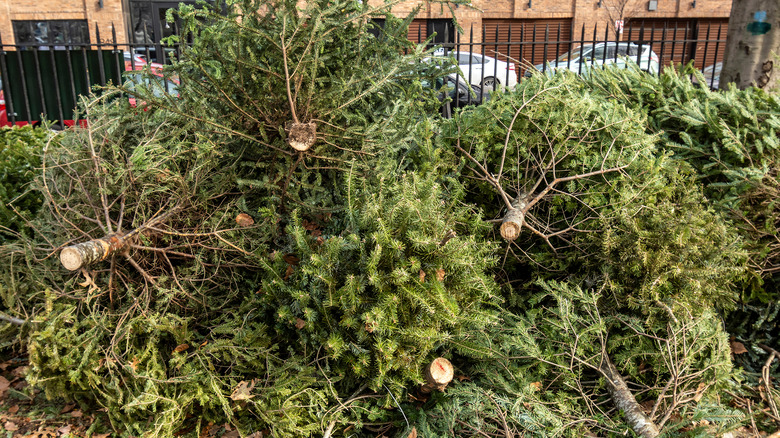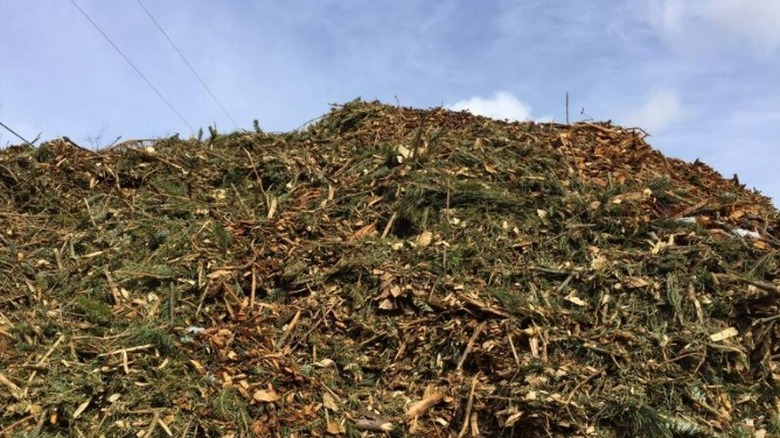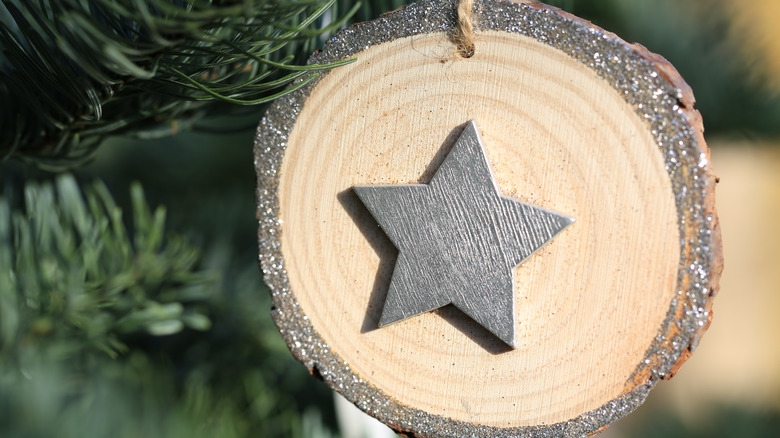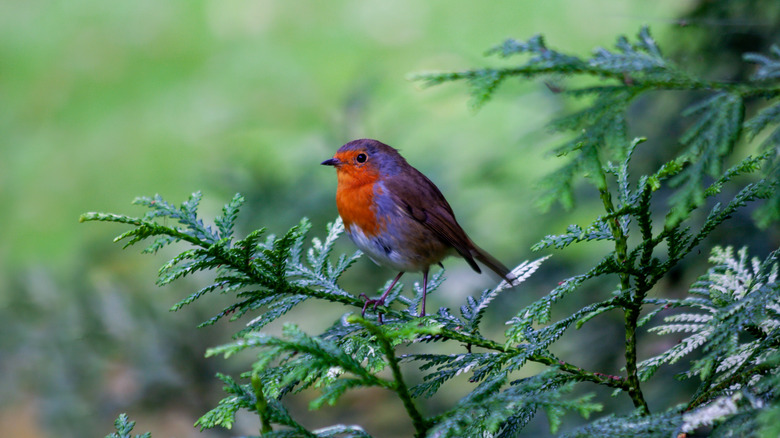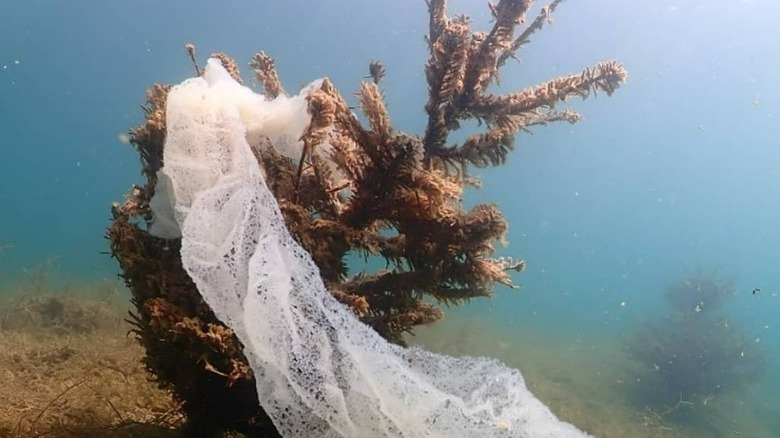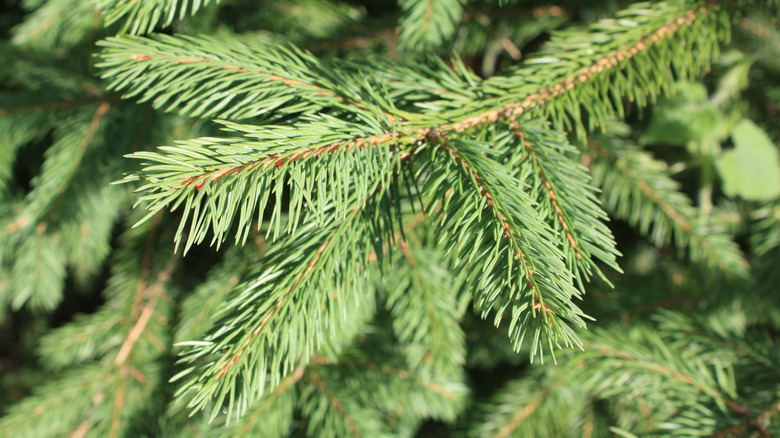Creative And Eco-Friendly Ways To Recycle Your Christmas Tree
It's hard not to want to go with a real tree for your Christmas celebration. Part of the Yuletide fun is to enjoy its beauty as it stands there in your living room, all decked out with lights and sustainable holiday ornaments. (And don't forget that fresh pine smell.) But once the holidays are over and your tree is beginning to, you know, actually look dead, what are you supposed to do with it? Yes, you can take it to the curb and hope that your recycling peeps will come to pick it up. But the harsh reality is that every year, millions of Christmas trees will still end up in landfills, where they'll slowly break down and produce methane gas into the atmosphere (via Sierra).
While cutting it down into smaller pieces and turning it into firewood might seem like an option, Solo Stove writes that the sap and needles are highly flammable and will most definitely send out sparks. Oh, and the smoke is toxic. Another thing to ponder is that burning wood is no longer considered to be carbon-neutral and, in fact, pollutes the atmosphere, as noted by Ecobnb. So now what? When it comes to creative and earth-friendly ways to recycle your tree, we've got you covered. Some have a bit more work involved, but that's okay. It's with the effort in order to make sure that our planet is taken care of.
Turn your tree into firewood or mulch
It's already been established that burning your tree isn't good for the planet, and the smoke it gives off is toxic if inhaled. But what you're probably not expecting is that turning your Christmas tree into mulch is the most ecologically sound way of recycling it. According to the Almanac, mulch is just organic matter that's used in landscaping and is meant to protect the soil and germinating seeds it's covering. Think of it like a protective, insulating blanket that keeps plant life warm during the winter months and prevents burning during the hotter times of the year.
In order to make your own mulch, you're going to need some help. Unless you already have a chipper in your yard maintenance arsenal or know someone who does, you'll have to go and rent one. (They should be available at most home improvement stores, but make sure you call and check first.) Luckily, chippers aren't too expensive and can cost anywhere from $69 to $125 a day, as noted by the landscaping blog Backyard Scape. Lastly, don't forget to thank your tree for its service before you send it to the chipper (just like KonMari always says).
Use the trunk for craft projects
You're going to want to break your tree into smaller, more manageable pieces before sending it down the chipper, which means you can take off as much of the trunk as you'd like for some fun DIY crafts projects. For example, a fun way to memorialize the holiday is by taking a piece of the trunk and either burning or painting the date and names of those involved in your Christmas celebration that year, and it could also be a nice family tradition. You could also make multiple different types of ornaments and give them out as gifts the following year.
Why not take it one step further and make some super rustic tealight holders, like the ones on The Wood Grain Cottage? You can use a longer trunk piece or just make smaller 2- to 3-inch tall discs for smaller centerpieces. Trunk slices can also make great coasters and can be personalized if you have a wood-burning pen or even a laser etching machine.
Turn your tree into a bird sanctuary
If you have the room, you might want to consider keeping your defunct Christmas tree outside in your backyard. If you live in an area that experiences cold weather, then consider this to be a particularly kind gesture towards flora and fauna living around you. That's because, in the cold, snowy weather, trees that are deciduous lose their leaves, per the National Association of State Foresters, which ultimately means that there's nowhere for birds and other small critters to shelter from the elements.
Your Christmas tree could actually be transformed into a safe haven for nature, per Oklahoma State University. Add some homemade bird feeders like orange slices, cranberry garlands, or even just scooped-out orange shells filled with seeds. With all of that wildlife, you might just take up birdwatching as your new favorite hobby. Your tree will eventually begin to dry out and will actually turn into natural mulch, which is also great for keeping your garden happy and healthy.
Let your tree become part of the aquatic ecosystem
Here's a fun one that you probably never thought about. Have you ever gone camping or hiking and noticed fallen trees that are rotting away in lakes or rivers? That's nature's way of taking care of aquatic life. Tracker Boats explains that sunken trees don't just act as shelter for fish. These trees will actually begin to feed anything that's living underwater. This is because once it starts to decompose, algae pop up. Fish nom-nom on the nasty green stuff, as do other little underwater bugs. Some fish might even use your tree as a place to lay eggs. All of this action will undoubtedly bring in bigger creatures, and so on. Your Christmas tree has now become a holiday underwater buffet. (How cool is that?)
A friendly reminder: it's always best to call and find out if dumping your Christmas tree into your local bass fishing lake is allowed. US News & World Report notes that states like West Virginia, South Carolina, Louisiana, and California all have Christmas tree recycling programs that benefit aquatic life. And, of course, don't forget to remove all decorations and hooks before you toss your tree back into nature.
Use your tree to protect and rejuvenate your garden
While mulch has been the main go-to for Christmas tree recycling, there are other ways you can use pieces of the shrub to protect your outdoor space (other than chipping it to death). The trunk can be used as a support structure for a greenhouse or other creeping foliage or as pathway liners. Pine boughs can be used as insulation for plants that might need a little extra warmth during the winter or sun protection during summer.
Pine needles themselves are great as compost, notes the blog Gardening. Because they're seed free, you don't have to worry about a Christmas tree somehow sprouting up in your yard. Pine needles are also completely carbon-neutral, unlike sawdust or other types of manufactured ground coverings. They're great for repelling certain unwanted animals because of smell aversion, which means you won't have to drive anywhere to buy questionable animal repellant, and the flora living in your outdoor zen den will remain safe, happy, and healthy.
